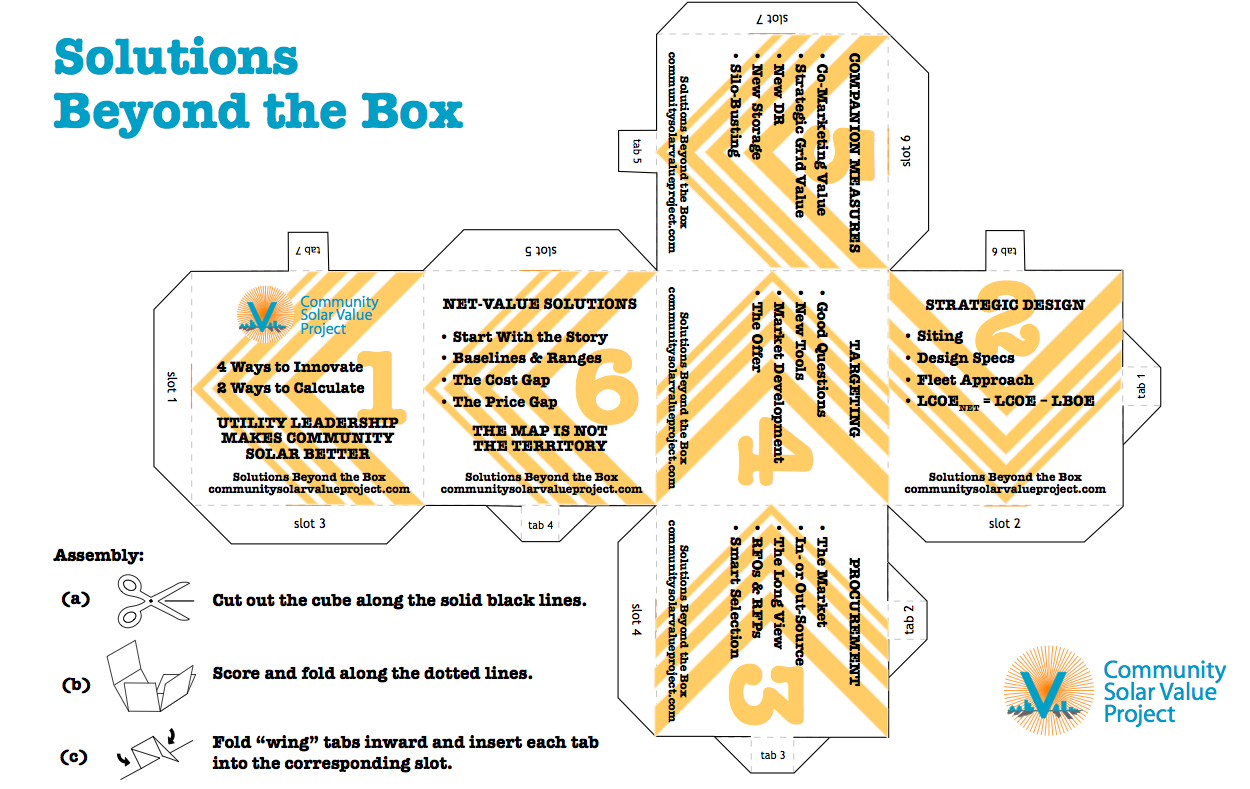
by Jill Cliburn
This fall, I was fortunate to participate in a meeting for public power utilities launching new efforts with the National Community Solar Partnership. Dozens of utility program managers shared insights regarding the kinds of support they would find useful to move community solar forward in different markets and while facing a range of technical, financial and pricing challenges. It was a time to listen and learn—but later, I realized that this Web site could help in Shared Solar Solutions from the work of those who came before. Our Community Solar Value Project (CSVP), worked with the Sacramento Municipal Utility District and dozens of other public power utilities in 2015-18 on what we called utility-driven community solar. We look forward to the NCSP and its new resources, especially addressing needs and opportunities that have emerged in the past few years. But if you are working on a community solar project or program right now, we are sure you will find many of our CSVP Solutions useful right "out of the box."
Here is a page by page guide that highlights some of our most enduring and popular resources under the Solutions tab:
The Process. The overview of the CSVP Process and lessons learned is still timely. I would suggest that other guidance documents, including the DOE-funded Solar in the Southeast Community Solar Implementation Guide (2018) might be useful, too, as well as other guides you can find on the NCSP website. In addition, the Process web page links to the rich and mostly relevant NRECA SUNDA project resources and to SEPA resources for utilities of all kinds.
Strategic Design. This page actually refers to both the project technical concept and the program delivery concept. Besides documents, this web page features presentations, such as an excellent webinar on the value-add for solar carports. As the cost of solar has dramatically fallen (even since our CSVP webinar) and as city land becomes more scarce, solar carports merit a second look.
Procurement. This was one of the CSVP's most popular topics and resource collections. The market landscape is obviously changed, but the Outsourcing Decision Key and Financing Models resources featured here are still timely. One of the most important early decisions for public power utilities is whether to acquire the solar resource or to work with a third party developer. If the former, the utility still faces financing decisions. CSVP explained pros and cons of options specifically relevant to consumer-owned utilities, including public power. Our financing guide was very popular. The posted webinar features outstanding work by public power utility leaders, including Erin Buchanan, formerly from Cedar Falls Utilities, Karen Poff from Austin Energy, and Ricardo Luna from CPS Energy (San Antonio). Also, we offered an RFP Library, including 11 examples. Watch for a new resource soon from our Solar-Plus for Electric Co-ops project, as we are adding new sample RFPs to help utilities procure solar plus battery storage projects.
Marketing. This is another set of timely resources—very popular with CSVP utility stakeholders. One reason it is timely is that our primary partner, SMUD, was far ahead of the game, regarding market segmentation. We took their work even farther, working with Grounded Research and Consulting to create a concise market research guide. Some utility-driven community solar programs have failed to achieve full subscription, so preparing program managers to include marketing in their plans is very important. It is frankly on our wish list to add newer resources on gearing community solar for low-income customers (NCSP has a treasure trove; also recommended would be CESA). CSVP ended before that market segment really took off.
In our section on Assessment the CSVP focused on showing how the municipal utility could incorporate benefits that are not included a typical solar-value model (from incorporating community or jobs-development goals to customer-retention). "Hard-to-monetize values" have since become an active topic, and a focus of our new work on Solar-Plus (for which, YES, we will be releasing a modeling tool in 2020). If you Contact us, we can recommend several resources and models available today. For example, we suggest one that is widely available is through the Solar in the Southeast effort.
Another relevant resource our Solutions pages is the pricing matrix, which describes how a dozen utilities (mostly public power) priced their programs. Keep an eye on the NCSP for updates, but for any utility manager who is new to this game, reviewing the options listed on slightly older pricing matrix is still instructive. It takes a while for a program innovations to take hold; I added a blog recently (see below) that discusses how SMUD applied some of the thinking we discussed 3 to 5 years ago in new community solar and shared storage programs. I for one will be delighted to support the next round of community solar innovators—perhaps including you!

Above: The CSVP asserted that utility program managers' real world experience called for a planning process that could respond to changing customer needs, policies, budgets and awareness of rising opportunities. There is an ideal order to the events we experience, but we come to value planning flexibility and creative responses to whatever challenges arise. This approach seems all the more relevant since Covid has come into our world!

 RSS Feed
RSS Feed